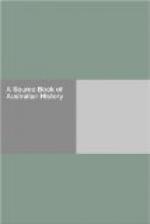Item 5th do. The high round mountain which we had seen the day before bore now due W. of us at 6 miles’ distance. At this point the land fell off to the N.W. so that we could no longer steer near the coast here, seeing that the wind was almost ahead. We therefore convened the Council and the second mates, with whom after due deliberation we resolved, and subsequently called out to the officer of the Zeehaen that pursuant to the resolution of the 11th ultimo, we should direct our course due east, and on the said course run to the full longitude of 195 deg., or the Salamonis Islands. Set our course due east in order to make further discoveries.
[This course brought them to New Zealand.]
DESCRIPTION OF WESTERN AUSTRALIA
+Source.+—The Voyages and Adventures of Captain William Dampier (published 1776). Vol. II, pp. 134-40
Dampier was an Englishman who had joined a company of American buccaneers. They arrived in May 1698 on the Western coast of Australia, which was by this time fairly well known to the Dutch under the name of New Holland.
New Holland is a very large tract of land. It is not yet determined whether it is an island or a main continent; but I am certain that it joins neither to Asia, Africa nor America. This part of it that we saw is all low even land, with sandy banks against the sea, only the points are rocky, and so are some of the islands in this bay.
The land is of a dry sandy soil, destitute of water, except you make wells; yet producing divers sorts of trees, but the woods are not thick, nor the trees very big. Most of the trees that we saw are dragon-trees as we supposed, and these too are the largest trees of any there.
They are about the bigness of our large apple-trees, and about the same height, and the rind is blackish and somewhat rough. The leaves are of a dark colour; the gum distils out of the knots or cracks that are in the bodies of the trees. We compared it with some gum dragon, or dragon’s blood, that was on board, and it was of the same colour and taste. The other sorts of trees were not known by any of us. There was pretty long grass growing under the trees, but it was very thin. We saw no trees that bore fruit or berries.
We saw no sort of animal, nor any track of beast, but once, and that seemed to be the tread of a beast as big as a mastiff dog. Here are a few small land-birds, but none bigger than a black-bird and but few sea fowls.
Neither is the sea very plentifully stored with fish, unless you reckon the manatee and turtle as such. Of these creatures there is plenty, but they are extraordinary shy, though the inhabitants cannot trouble them much, having neither boats nor iron.




